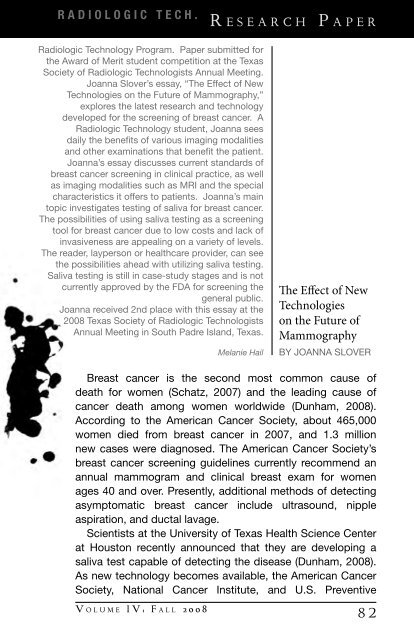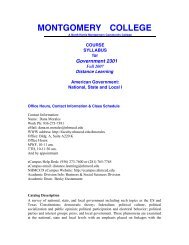2008 - Communication Across the Curriculum (CAC)
2008 - Communication Across the Curriculum (CAC)
2008 - Communication Across the Curriculum (CAC)
Create successful ePaper yourself
Turn your PDF publications into a flip-book with our unique Google optimized e-Paper software.
R a d i o l o g i c T e c h .<br />
R e s e a r c h P a p e r<br />
Radiologic Technology Program. Paper submitted for<br />
<strong>the</strong> Award of Merit student competition at <strong>the</strong> Texas<br />
Society of Radiologic Technologists Annual Meeting.<br />
Joanna Slover’s essay, “The Effect of New<br />
Technologies on <strong>the</strong> Future of Mammography,”<br />
explores <strong>the</strong> latest research and technology<br />
developed for <strong>the</strong> screening of breast cancer. A<br />
Radiologic Technology student, Joanna sees<br />
daily <strong>the</strong> benefits of various imaging modalities<br />
and o<strong>the</strong>r examinations that benefit <strong>the</strong> patient.<br />
Joanna’s essay discusses current standards of<br />
breast cancer screening in clinical practice, as well<br />
as imaging modalities such as MRI and <strong>the</strong> special<br />
characteristics it offers to patients. Joanna’s main<br />
topic investigates testing of saliva for breast cancer.<br />
The possibilities of using saliva testing as a screening<br />
tool for breast cancer due to low costs and lack of<br />
invasiveness are appealing on a variety of levels.<br />
The reader, layperson or healthcare provider, can see<br />
<strong>the</strong> possibilities ahead with utilizing saliva testing.<br />
Saliva testing is still in case-study stages and is not<br />
currently approved by <strong>the</strong> FDA for screening <strong>the</strong><br />
general public.<br />
Joanna received 2nd place with this essay at <strong>the</strong><br />
<strong>2008</strong> Texas Society of Radiologic Technologists<br />
Annual Meeting in South Padre Island, Texas.<br />
Melanie Hail<br />
The Effect of New<br />
Technologies<br />
on <strong>the</strong> Future of<br />
Mammography<br />
by Joanna Slover<br />
Breast cancer is <strong>the</strong> second most common cause of<br />
death for women (Schatz, 2007) and <strong>the</strong> leading cause of<br />
cancer death among women worldwide (Dunham, <strong>2008</strong>).<br />
According to <strong>the</strong> American Cancer Society, about 465,000<br />
women died from breast cancer in 2007, and 1.3 million<br />
new cases were diagnosed. The American Cancer Society’s<br />
breast cancer screening guidelines currently recommend an<br />
annual mammogram and clinical breast exam for women<br />
ages 40 and over. Presently, additional methods of detecting<br />
asymptomatic breast cancer include ultrasound, nipple<br />
aspiration, and ductal lavage.<br />
Scientists at <strong>the</strong> University of Texas Health Science Center<br />
at Houston recently announced that <strong>the</strong>y are developing a<br />
saliva test capable of detecting <strong>the</strong> disease (Dunham, <strong>2008</strong>).<br />
As new technology becomes available, <strong>the</strong> American Cancer<br />
Society, National Cancer Institute, and U.S. Preventive<br />
V o l u m e I V : F a l l 2 0 0 8<br />
8 2






